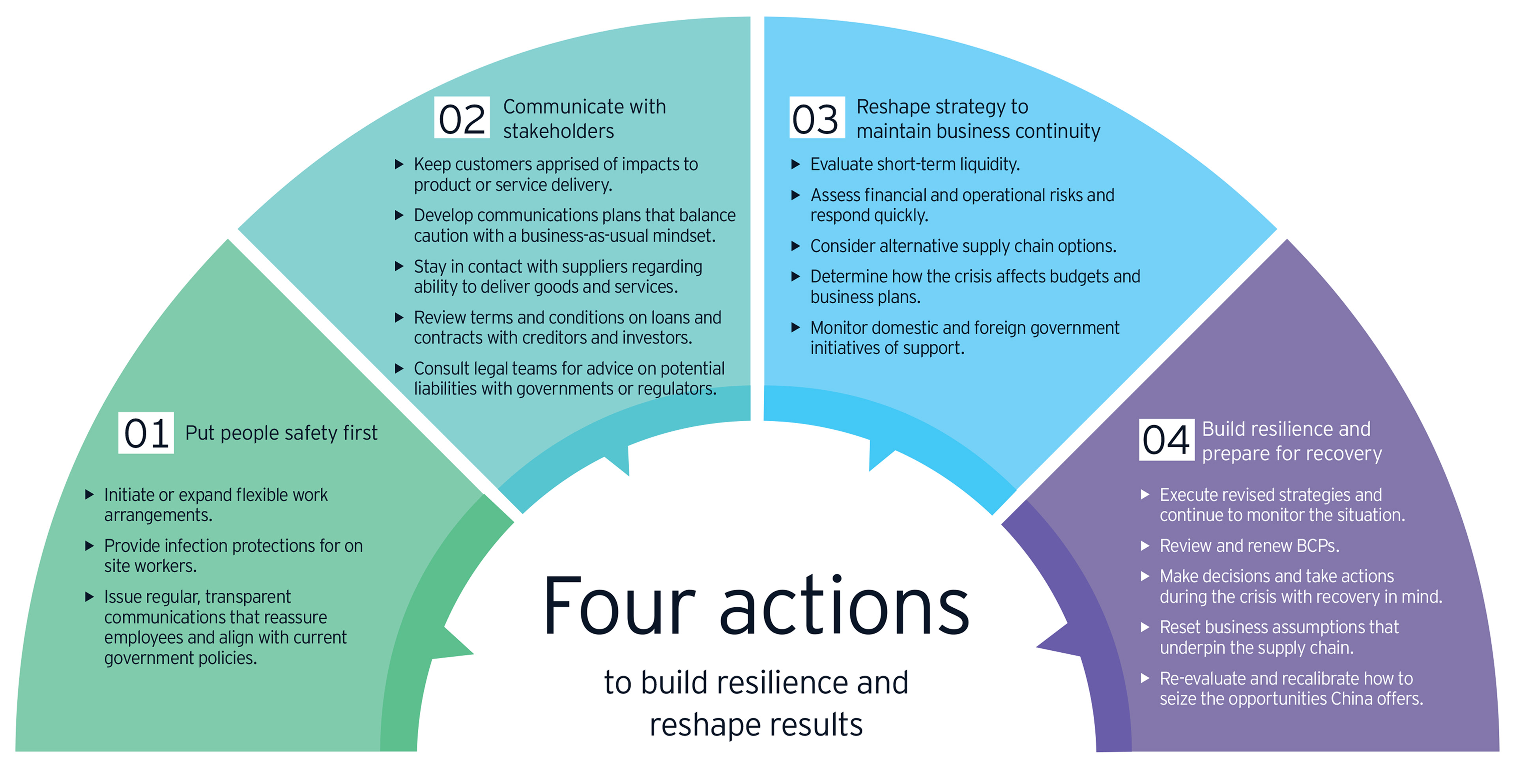
Chapter 1
Five ways to lessen the COVID-19 impact
Global companies have to be predictive and proactive in their decision-making to preserve continuity and build resilience.
As global companies grapple with an ongoing and evolving situation, we have identified five priorities for them to consider.
1. Prioritize people safety and continuous engagement
Ensuring the safety and wellbeing of the employees in the workplace is essential. People are looking to their employer, community and government leaders for guidance. Addressing their concerns in an open and transparent manner will go a long way to engaging them and reassuring the business continuity.
One of the adjustments companies have to make is to initiate or expand flexible work arrangements and other policies that allow people to work remotely and safely. Depending on the sector, companies will want to reorganize teams and reallocate resources, and establish employee wellbeing programs and policies that support a safe working environment. Additionally, companies will want to produce regular communications that align with current government and health authorities’ policies to help employees remain engaged as they and the organization navigate through the crisis.
Finding ways to reimagine a business-as-usual environment that minimizes disruptions for the organization requires a fine balance. Where telecommuting or flexible work arrangements aren’t possible and companies must have workers on site or in direct contact with customers, it is important to provide infection protections measures.
To help companies provide safe work environments, municipal governments in Zhejian and Fujian are chartering buses, trains and flights to transport their employees back to work. Other local governments are working with big data amassed by technology companies and mobile operators to develop a health QR code system that allows people to track their movements over the previous 14 days to prove that they haven’t visited any high-risk areas. Still other governments centrally and locally are exempting or deferring, in part or in full, social insurance and rental payments.
Finding ways to reimagine a business-as-usual environment that minimizes disruptions for the organization requires a fine balance.
Even with all these measures, there will be businesses that will experience workforce disruptions. For companies operating in China, this is a notable challenge, especially for many manufacturing businesses. Labor shortages and increased costs due to mobility restrictions that various state and local government authorities have imposed will impact businesses. Companies that experience unique challenges, not covered by specific policies already issued, should seek advice from their local governments for guidance. Outside of China, governments have introduced assistance programs for sectors such as tourism and travel that are being severely impacted by COVID-19.
2. Reshape strategy for business continuity
Most businesses are likely to experience significant disruption to their business-as-usual operations and will face business underperformance throughout the duration of the COVID-19 crisis. This is especially true for companies that either are operating in or exposed to China. These companies will experience disruption to their supply chain and production commitments, as well as significant shifts in consumer demands and behavior impacting several sectors such as consumer and retail, manufacturing, life sciences and automotive.
To help address these challenges, companies will want to:
- Evaluate short-term liquidity. Companies will want to instill short-term cash flow monitoring discipline that allows them to predict cash flow pressures and intervene in a timely manner. They’ll also want to maintain strict discipline on working capital, particularly around collecting receivables and managing inventory build-up. Additionally, it’s important to be creative and proactively intervene to lighten the working capital cycle. Throughout the crisis, companies will want to maintain regular contact with suppliers to identify any potential risks.
- Assess financial and operational risks and respond quickly. Companies will need to monitor direct cost escalations and their impact on overall product margins, intervening and renegotiating, where necessary. Companies that are slow to react or unable to renegotiate new terms and conditions may be vulnerable to financial stress that could carry long-term implications.
Just as companies need to monitor their in-house vulnerabilities, they also will need to monitor the pressures that may be impacting some of their customers, suppliers, contractors or alliance partners. In particular, companies will want to stress test any tier one and tier two suppliers that may be impacted. This is especially important for sectors such as automotive and pharmaceutical, which are highly dependent on third-party suppliers. Finally, be aware of covenant breaches with banking facilities and other financial institutions relating to impairment risks in asset values, which may impact the health of the overall balance sheet.
- Consider alternative supply chain options. Companies that source parts or materials from suppliers in areas significantly impacted by COVID-19 will want to look for alternatives. For example, a Japanese industrials manufacturer is considering moving the assembly of commercial air conditioners to Malaysia from the Hubei Province capital of Wuhan, which remains under lockdown. Similarly, a global apparel company is looking to move production of its products from facilities in Wuhan to Vietnam and Indonesia. Such quick moves will create temporary capacity to meet customer obligations. Companies that have arrangements with agile manufacturing facilities to make spot buying decisions, or have loose contractual arrangements with various service providers and logistics providers, should consider the initial disruption as well as post-crisis scenarios given the potential for demand spikes.
Organizations that operate with transparency and open communication have inherent advantages when events require quick actions to react and reshape.
- Determine how the COVID-19 crisis affects budgets and business plans. Companies will want to stress-test financial plans for multiple scenarios to understand the potential impact on financial performance and assess how long the impact may continue. If the impact is material and former budget assumptions and business plans are no longer relevant, companies should revise them to remain agile. Where the business is significantly impacted, companies will need to consider minimum operating requirements, including key dependencies of workforce, vendors, location and technology.
There is also the issue of short-term capital demands for continuous business operations. Based on the outcome of the assessment, companies may need to look at near-term capital raising, debt refinancing or additional credit support from banks or investors, or policy supports from the government. At the same time, companies will need to review overall operating costs and consider slowing down or curtailing all non-essential expenses.
3. Communicate with relevant stakeholders
Clear, transparent and timely communications are necessary when creating a platform to reshape the business and to secure ongoing support from customers, employees, suppliers, creditors, investors and regulatory authorities.
- Customers. Companies will want to keep customers apprised of any impacts to product or service delivery. If contractual obligations cannot be met as a result of supplier or production disruption, it is important to maintain open lines of communication to revisit timelines or invoke “force majeure” or “act of God” clauses. Such proactive action will help to mitigate punitive damages or liabilities associated with disrupted customer obligations.
- Employees. For employees, communications plans should try to find the balance between caution and maintaining a business-as-usual mindset.
- Suppliers. Companies need maintain regular contact with suppliers regarding their capability to deliver goods and services during the COVID-19 crisis and their recovery plans, so that the company can consider alternative supply chain options in a timely manner.
- Creditors and investors. Companies will want to review terms and conditions on loan contracts to identify sensitive debts and avoid vital technical debt breaches. These reviews will have the added benefit of giving companies a chance to proactively manage the dialogue and communications with creditors regarding any necessary amendments to existing terms or refinancing arrangements.
- Government and regulators. When communicating with relevant stakeholders, companies will want to consult with their legal teams for advice on potential liabilities and with their business units regarding how to manage communications around ongoing breaches and collection of proof, if any.
Companies have to ask themselves whether they have the right supply chain and agility to withstand a three-month disruption.
4. Maximize the use of government support policies
Central and local governments in China have released several financial, social insurance and tax-related policies to support companies. This includes the China Securities Regulatory Commission’s (CSRC) interim policy on listed companies refinancing.
Companies should monitor these and other nation-wide government and organizational opportunities for support and how they may best serve the individual circumstances of their organization. It is important to note that government support may differ based on jurisdiction and sector. Companies will need to identify and understand each offer of support and determine which ones are best for their organization.
The China State Taxation Administration (STA) has published a series of policies to provide support for preventing and treating the epidemic, including:
- Exempting and refunding value added tax (VAT) for enterprises providing certain services for epidemic control or manufacturing key epidemic-related necessities.
- Offering a full corporate income tax (CIT) deduction for purchasing equipment to manufacture epidemic prevention-related supplies.
- Providing an individual income tax (IIT) exemptions on bonuses and allowances relevant personnel receive for treating the epidemic.
- Issuing other policies that encourage public-benefit donations.
Temporary social insurance contribution reductions and exemptions the STA and Ministry of Finance (MOF) have introduced also have helped to ease the burden on companies.
Other countries impacted by the crisis, including Singapore and Japan, are introducing similar government policies. Companies should monitor the availability of these kinds of programs and use them to mitigate the risks they face.
5. Build resilience in preparation for the new normal
Once companies have solidified strategies based on stress tests and communicated any new directions with relevant stakeholders, they will need to execute based on revised plans while monitoring what continues to be a fluid situation. Senior management should report any material deviation from the plan in a timely manner so that their companies can take additional action to avoid further negative impact.
Once the COVID-19 outbreak is controlled, companies will want to review and renew business continuity plans (BCP). They’ll want to assess how existing BCPs are working. If there are deficiencies, companies will want to identify root causes, whether it’s timeliness of action, lack of infrastructure, labor shortages, or external environment issues. Companies will then want to consider putting new internal guidelines in place based on lessons learned, as well as solid contingency plans to build resilience and better respond to future crises.
Financial services organizations have an ethical opportunity to develop more agile products for working capital and short-term loans to support the economy.

Chapter 2
Plan for recovery now, not later
Although there are lessons to learn after the fact, companies should be making decisions during the crisis with recovery in mind.
COVID-19 is more than a China issue and more than a moment in time. Companies will want to make long-term adjustments that include China rather than reactionary short-term pivots.
As a black swan event, the COVID-19 crisis is impossible to predict with conventional wisdom and forecasting tools. However, there are many lessons companies can learn and carry forward once the crisis has passed and they’ve had a chance to analyze their response.
In the meantime, companies should be making decisions and taking actions during crisis with recovery in mind. When the crisis is over, it will be clear which companies have the resilience and agility to reshape their business strategy to thrive in the future.
Longer term, companies will need to consider how robust their business, management team and initiatives were in facing the crisis. It will also be important to consider and reset the business assumptions that underpin the supply chain and other concentrations that many businesses have been exposed to over time.
One of the biggest lessons companies will learn when planning for recovery is how important their businesses relate to and navigate China. As a market of approximately one and a half billion people and the world’s second largest economy, China remains relevant to any business that has global ambitions. How businesses tap into the vast opportunities that China offers may see some reimagination and recalibration.
Once the situation is mitigated, companies should reevaluate how robust their business management was facing the crisis, and then analyze options to become more resilient against future disruptions.

Summary
In what can be described as a black swan event, companies around the world are coming to terms with the impact the coronavirus (COVID-19) is having on their business. Although the risks are considerable, the crisis also reveals areas where companies can build resilience and reshape results.


